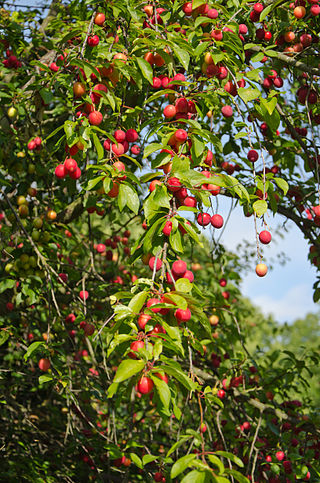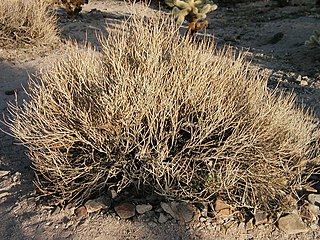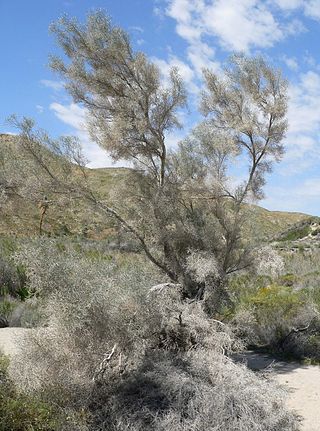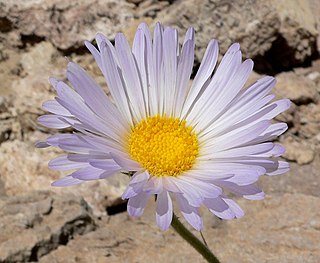
Prunus cerasifera is a species of plum known by the common names cherry plum and myrobalan plum. It is native to Southeast Europe and Western Asia, and is naturalised in the British Isles and scattered locations in North America. Also naturalized in parts of SE Australia where it is considered to be a mildly invasive weed of bushland near urban centers.

Eremalche rotundifolia, the desert five-spot, is a flowering plant in the family Malvaceae, native to the Mojave Desert and Colorado Desert in the Southwestern United States.

Senna covesii is a perennial subshrub in the family Fabaceae, native to the Mojave Desert and Sonoran Desert in southeastern California, southern Nevada, and Arizona in the United States, and northern Baja California in Mexico. It is found on desert plains and in sandy washes between 500 and 600 m above sea level, and is very common in Joshua Tree National Park. The specific epithet honors ornithologist Elliott Coues.

Parkinsonia florida, the blue palo verde, is a species of palo verde native to the Sonoran Deserts in the Southwestern United States and Northwestern Mexico. Its name means "green pole or stick" in Spanish, referring to the green trunk and branches, that perform photosynthesis.

Prunus ilicifolia is native to the chaparral areas of coastal California, Baja California, and Baja California Sur. as well as the desert chaparral areas of the Mojave desert.

Prunus subcordata, known by the common names Klamath plum, Oregon plum, Pacific plum and Sierra plum, is a member of the genus Prunus, native to the western United States, especially California and Oregon.

Psorothamnus spinosus, or Delea spinosa, is a perennial legume tree of the deserts in North America. Common names include smokethorn, smoketree, smoke tree, smokethorn dalea, and corona de Cristo.

Prunus fremontii is a North American species of plants in the rose family, known by the common name desert apricot. It takes its scientific name from John C. Frémont. It is found in northern and western Baja California especially, mostly Pacific and western, and the adjacent area of southern California. It also occurs in northern Baja California Sur.

Astragalus bernardinus, known by the common name San Bernardino milkvetch or the Lesser Three-keeled Milkvetch, is a species of milkvetch. It is a plant of desert and dry mountain slope habitat. It is native to California.

Rafinesquia neomexicana is a species of flowering plant in the family Asteraceae. Common names include desert chicory, plumeseed, or New Mexico plumeseed. It has white showy flowers, milky sap, and weak, zigzag stems, that may grow up through other shrubs for support. It is an annual plant found in dry climate areas of the southwestern deserts of the US and northwestern deserts of Mexico.

Oenothera primiveris is a species of flowering plant in the evening primrose family known by the common names yellow desert evening primrose, bottle evening-primrose, and desert evening-primrose.

Prunus caroliniana, known as the Carolina laurelcherry, Carolina cherry laurel, Carolina cherry, or Cherry laurel, is a small evergreen flowering tree native to the lowlands of Southeastern United States, from North Carolina south to Florida and westward to central Texas. The species also has escaped into the wild in a few places in California.

Tetracoccus hallii is a species of flowering shrub in the family Picrodendraceae, known by the common names Hall's shrubby-spurge and Hall's tetracoccus.
Tetracoccus ilicifolius is a rare species of flowering shrub in the family Picrodendraceae known by the common names hollybush and holly-leaved tetracoccus.

Xylorhiza tortifolia is a species of flowering plant in the family Asteraceae, known by the common names Mojave-aster and Mojave woodyaster.

Ericameria paniculata is a species of flowering plant in the sunflower family Asteraceae, native to the southwestern United States. It is an evergreen yellow-flowered desert shrub.

Ambrosia salsola, commonly called cheesebush, winged ragweed, burrobush, white burrobrush, and desert pearl, is a species of perennial shrub in the family Asteraceae native to deserts of the southwestern United States and northwestern Mexico.

Funastrum cynanchoides, also known as fringed twinevine, twining milkweed or climbing milkweed, is a perennial plant in the family Apocynaceae that grows twining through other plants in the Mojave Desert and Sonoran Desert. It has milky sap and smells pungent. It is similar to Funastrum hirtellum.

Tidestromia suffruticosa, the shrubby honeysweet, is a perennial plant in the family Amaranthaceae of the southwestern United States and northeastern Mexican deserts. It has one of the highest rates of photosynthesis ever recorded. It flowers from April to December. It can survive very high temperatures, growing successfully in extreme environments such as Death Valley, and the genetic basis for this is being studied with a view to making hardier crop plants to better cope with climate change.

Prunus minutiflora, called the Texas almond, is a shrub native to Texas and northern Mexico.



















